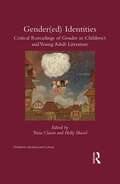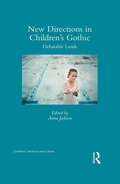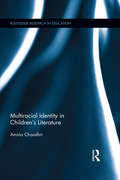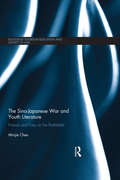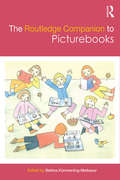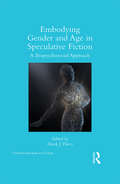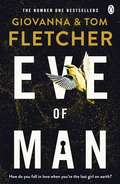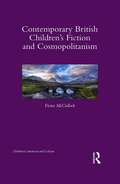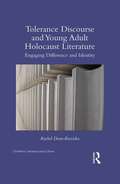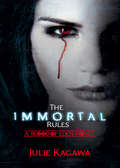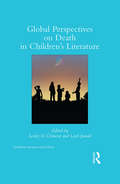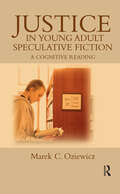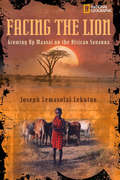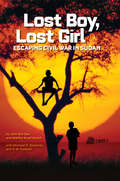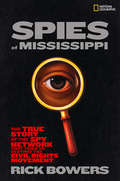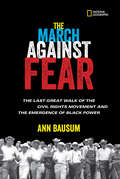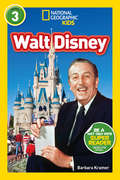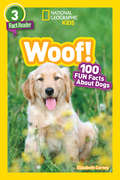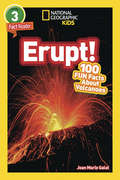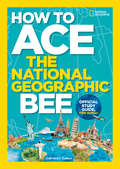- Table View
- List View
Gender: Critical Rereadings of Gender in Children's and Young Adult Literature (Children's Literature and Culture)
by Tricia Clasen Holly HasselThis volume brings together diverse, cross-disciplinary scholarly voices to examine gender construction in children's and young adult literature. It complements and updates the scholarship in the field by creating a rich, cohesive examination of core questions around gender and sexuality in classic and contemporary texts. By providing an expansive treatment of gender and sexuality across genres, eras, and national literature, the collection explores how readers encounter unorthodox as well as traditional notions of gender. It begins with essays exploring how children's and YA literature construct communities formed by gender, ethnicity, sexuality, and in face-to-face and virtual spaces. Section II's central focus is how gendered identities are formed, unpacking how texts for young readers ranging from Amish youth periodicals to the blockbuster Divergent series trace, reproduce, and shape gendered identity socialization. In section III, the essential literary function of translating trauma into narrative is addressed in classics like Anne of Green Gables and Pollyanna, as well as more recent works. Section IV's focus on sexuality and romance encompasses fiction and nonfiction works, examining how children's and young adult literature can serve as a regressive, progressive, and transgressive site for construction meaning about sex and romance. Last, Section IV offers new readings of paratextual features in literature for children -- from the classic tale of Cinderella to contemporary illustrated novels. The key achievement of this volume is providing an updated range of multidisciplinary and methodologically diverse analyses of critically and commercially successful texts, contributing to the scholarship on children's and YA literature; gender, sexuality, and women's studies; and a range of other disciplines.
New Directions in Children's Gothic: Debatable Lands (Children's Literature and Culture)
by Anna JacksonChildren’s literature today is dominated by the gothic mode, and it is in children’s gothic fictions that we find the implications of cultural change most radically questioned and explored. This collection of essays looks at what is happening in the children’s Gothic now when traditional monsters have become the heroes, when new monsters have come into play, when globalisation brings Harry Potter into China and yaoguai into the children’s Gothic, and when childhood itself and children’s literature as a genre can no longer be thought of as an uncontested space apart from the debates and power struggles of an adult domain. We look in detail at series such as The Mortal Instruments, Twilight, Chaos Walking, The Power of Five, Skulduggery Pleasant, and Cirque du Freak; at novels about witches and novels about changelings; at the Gothic in China, Japan and Oceania; and at authors including Celia Rees, Frances Hardinge, Alan Garner and Laini Taylor amongst many others. At a time when the energies and anxieties of children’s novels can barely be contained anymore within the genre of children’s literature, spilling over into YA and adult literature, we need to pay attention. Weird things are happening and they matter.
New Directions in Children's Gothic: Debatable Lands (Children's Literature and Culture)
by Anna JacksonChildren’s literature today is dominated by the gothic mode, and it is in children’s gothic fictions that we find the implications of cultural change most radically questioned and explored. This collection of essays looks at what is happening in the children’s Gothic now when traditional monsters have become the heroes, when new monsters have come into play, when globalisation brings Harry Potter into China and yaoguai into the children’s Gothic, and when childhood itself and children’s literature as a genre can no longer be thought of as an uncontested space apart from the debates and power struggles of an adult domain. We look in detail at series such as The Mortal Instruments, Twilight, Chaos Walking, The Power of Five, Skulduggery Pleasant, and Cirque du Freak; at novels about witches and novels about changelings; at the Gothic in China, Japan and Oceania; and at authors including Celia Rees, Frances Hardinge, Alan Garner and Laini Taylor amongst many others. At a time when the energies and anxieties of children’s novels can barely be contained anymore within the genre of children’s literature, spilling over into YA and adult literature, we need to pay attention. Weird things are happening and they matter.
Multiracial Identity in Children's Literature: Reading Diversity In the Classroom (Routledge Research in Education)
by Amina ChaudhriRacially mixed children make up the fastest growing youth demographic in the U.S., and teachers of diverse populations need to be mindful in selecting literature that their students can identify with. This volume explores how books for elementary school students depict and reflect multiracial experiences through text and images. Chaudhri examines contemporary children’s literature to demonstrate the role these books play in perpetuating and resisting stereotypes and the ways in which they might influence their readers. Through critical analysis of contemporary children’s fiction, Chaudhri highlights the connections between context, literature, and personal experience to deepen our understanding of how children’s books treat multiracial identity.
The Sino-Japanese War and Youth Literature: Friends and Foes on the Battlefield (Routledge Studies in Education and Society in Asia)
by Minjie ChenThe Sino-Japanese War (1937 – 1945) was fought in the Asia-Pacific theatre between Imperial Japan and China, with the United States as the latter’s major military ally. An important line of investigation remains, questioning how the history of this war has been passed on to post-war generations’ consciousness, and how information sources, particularly those exposed to young people in their formative years, shape their knowledge and bias of the conflict as well as World War II more generally. This book is the first to focus on how the Sino-Japanese War has been represented in non-English and English sources for children and young adults. As a cross-cultural study and an interdisciplinary endeavour, it not only examines youth-orientated publications in China and the United States, but also draws upon popular culture, novelists’ memoirs, and family oral narratives to make comparisons between fiction and history, Chinese and American sources, and published materials and private memories of the war. Through quantitative narrative analysis, literary and visual analysis, and socio-political critique, it shows the dominant pattern of war stories, traces chronological changes over the seven decades from 1937 to 2007, and teases out the ways in which the history of the Sino-Japanese War has been constructed, censored, and utilized to serve shifting agendas. Providing a much needed examination of public memory, literary representation, and popular imagination of the Sino-Japanese War, this book will have huge interdisciplinary appeal, particularly for students and scholars of Asian history, literature, society and education.
The Routledge Companion to Picturebooks (Routledge Literature Companions)
Containing forty-eight chapters, The Routledge Companion to Picturebooks is the ultimate guide to picturebooks. It contains a detailed introduction, surveying the history and development of the field and emphasizing the international and cultural diversity of picturebooks. Divided into five key parts, this volume covers: Concepts and topics – from hybridity and ideology to metafiction and emotions; Genres – from baby books through to picturebooks for adults; Interfaces – their relations to other forms such as comics and visual media; Domains and theoretical approaches, including developmental psychology and cognitive studies; Adaptations. With ground-breaking contributions from leading and emerging scholars alike, this comprehensive volume is one of the first to focus solely on picturebook research. Its interdisciplinary approach makes it key for both scholars and students of literature, as well as education and media.
The Routledge Companion to Picturebooks (Routledge Literature Companions)
Containing forty-eight chapters, The Routledge Companion to Picturebooks is the ultimate guide to picturebooks. It contains a detailed introduction, surveying the history and development of the field and emphasizing the international and cultural diversity of picturebooks. Divided into five key parts, this volume covers: Concepts and topics – from hybridity and ideology to metafiction and emotions; Genres – from baby books through to picturebooks for adults; Interfaces – their relations to other forms such as comics and visual media; Domains and theoretical approaches, including developmental psychology and cognitive studies; Adaptations. With ground-breaking contributions from leading and emerging scholars alike, this comprehensive volume is one of the first to focus solely on picturebook research. Its interdisciplinary approach makes it key for both scholars and students of literature, as well as education and media.
Embodying Gender and Age in Speculative Fiction: A Biopsychosocial Approach (Children's Literature and Culture)
by Derek J. ThiessFollowing scholarship on gender in science fiction, this book explores the limits of considering age as a social construction, positing that an acknowledgement of aged bodies necessarily changes the way we read both age and science fiction. The volume employs contemporary clinical psychology, the biopsychosocial model, to demonstrate that age is an important and neglected topic relevant to the study of speculative fiction. While gender offers a vocabulary, the biopsychosocial approach provides a method to consider age (and gender) as an embodied synthesis of physicality, psychology, and social environment. This respected model of clinical psychology allows a unique and innovative lens through which to read age and the body in literature. Thiess offers readings of established sf classics including Octavia Butler’s Parable series; Orson Scott Card’s Ender’s Game; and cyberpunk authors such as Bruce Sterling, Pat Cadigan, and Neal Stephenson, also exploring more mainstream speculative works including Stephanie Meyer’s Twilight series and Joss Whedon’s Firefly/Serenity. Visiting topics such as care work, sexuality, sport, and the military in these works, the book demonstrates that acknowledging a more fully embodied age is not only necessary for the individual subject, but will also enrich our understanding of other social categories, including gender and race. Taking a constructive—rather than adversarial—stance, this book does not merely question how much one can ethically and responsibly "bend" age, but suggests there is a great deal to learn when one explores those limits.
Eve of Man: Eve of Man Trilogy, Book 1 (Eve of Man Trilogy #1)
by Tom Fletcher Giovanna FletcherThis is the electrifying dystopian love story, the first in the trilogy by bestselling authors Giovanna and Tom Fletcher.'. . . ONE OF THE BIG BOOKS OF THE YEAR. YOU'D BE A FOOL TO MISS IT' HEAT______________ Eve is like any other teenage girl . . .Except that the fate of the entire world lies on her shoulders.She's the first girl born in fifty years.She's the answer to their prayers.She's the final hope.Which means she has one function alone . . .At sixteen, Eve must face her destiny and make a choice.She will choose a man, one out of three carefully selected suitors.But what about Bram?The future of the planet hangs on Eve making the right choice.Will she?COULD YOU CHOOSE BETWEEN LOVE, AND THE FUTURE OF THE HUMAN RACE?
Contemporary British Children's Fiction and Cosmopolitanism (Children's Literature and Culture)
by Fiona McCullochThis book visits contemporary British children’s and young adult (YA) fiction alongside cosmopolitanism, exploring the notion of the nation within the context of globalization, transnationalism and citizenship. By resisting globalization’s dehumanizing conflation, cosmopolitanism offers an ethical, humanitarian, and political outlook of convivial planetary community. In its pedagogical responsibility towards readers who will become future citizens, contemporary children’s and YA fiction seeks to interrogate and dismantle modes of difference and instead provide aspirational models of empathetic world citizenship. McCulloch discusses texts such as J.K. Rowling’s Harry Potter series, Jackie Kay’s Strawgirl, Theresa Breslin’s Divided City, Gillian Cross’s Where I Belong, Kerry Drewery’s A Brighter Fear, Saci Lloyd’s Momentum, and Julie Bertagna’s Exodus trilogy. This book addresses ways in which children’s and YA fiction imagines not only the nation but the world beyond, seeking to disrupt binary divisions through a cosmopolitical outlook. The writers discussed envision British society’s position and role within a global arena of wide-ranging topical issues, including global conflicts, gender, racial politics, ecology, and climate change. Contemporary children’s fiction has matured by depicting characters who face uncertainty just as the world itself experiences an uncertain future of global risks, such as environmental threats and terrorism. The volume will be of significant interest to the fields of children’s literature, YA fiction, contemporary fiction, cosmopolitanism, ecofeminism, gender theory, and British and Scottish literature.
Contemporary British Children's Fiction and Cosmopolitanism (Children's Literature and Culture)
by Fiona McCullochThis book visits contemporary British children’s and young adult (YA) fiction alongside cosmopolitanism, exploring the notion of the nation within the context of globalization, transnationalism and citizenship. By resisting globalization’s dehumanizing conflation, cosmopolitanism offers an ethical, humanitarian, and political outlook of convivial planetary community. In its pedagogical responsibility towards readers who will become future citizens, contemporary children’s and YA fiction seeks to interrogate and dismantle modes of difference and instead provide aspirational models of empathetic world citizenship. McCulloch discusses texts such as J.K. Rowling’s Harry Potter series, Jackie Kay’s Strawgirl, Theresa Breslin’s Divided City, Gillian Cross’s Where I Belong, Kerry Drewery’s A Brighter Fear, Saci Lloyd’s Momentum, and Julie Bertagna’s Exodus trilogy. This book addresses ways in which children’s and YA fiction imagines not only the nation but the world beyond, seeking to disrupt binary divisions through a cosmopolitical outlook. The writers discussed envision British society’s position and role within a global arena of wide-ranging topical issues, including global conflicts, gender, racial politics, ecology, and climate change. Contemporary children’s fiction has matured by depicting characters who face uncertainty just as the world itself experiences an uncertain future of global risks, such as environmental threats and terrorism. The volume will be of significant interest to the fields of children’s literature, YA fiction, contemporary fiction, cosmopolitanism, ecofeminism, gender theory, and British and Scottish literature.
Tolerance Discourse and Young Adult Holocaust Literature: Engaging Difference and Identity (Children's Literature and Culture)
by Rachel Dean-RuzickaWhat, exactly, does one mean when idealizing tolerance as a solution to cultural conflict? This book examines a wide range of young adult texts, both fiction and memoir, representing the experiences of young adults during WWII and the Holocaust. Author Rachel Dean-Ruzicka argues for a progressive reading of this literature. Tolerance Discourse and Young Adult Holocaust Literature contests the modern discourse of tolerance, encouraging educators and readers to more deeply engage with difference and identity when studying Holocaust texts. Young adult Holocaust literature is an important nexus for examining issues of identity and difference because it directly confronts systems of power, privilege, and personhood. The text delves into the wealth of material available and examines over forty books written for young readers on the Holocaust and, in the last chapter, neo-Nazism. The book also looks at representations of non-Jewish victims, such as the Romani, the disabled, and homosexuals. In addition to critical analysis of the texts, each chapter reads the discourses of tolerance and cosmopolitanism against present-day cultural contexts: ongoing debates regarding multicultural education, gay and lesbian rights, and neo-Nazi activities. The book addresses essential questions of tolerance and toleration that have not been otherwise considered in Holocaust studies or cultural studies of children’s literature.
Tolerance Discourse and Young Adult Holocaust Literature: Engaging Difference and Identity (Children's Literature and Culture)
by Rachel Dean-RuzickaWhat, exactly, does one mean when idealizing tolerance as a solution to cultural conflict? This book examines a wide range of young adult texts, both fiction and memoir, representing the experiences of young adults during WWII and the Holocaust. Author Rachel Dean-Ruzicka argues for a progressive reading of this literature. Tolerance Discourse and Young Adult Holocaust Literature contests the modern discourse of tolerance, encouraging educators and readers to more deeply engage with difference and identity when studying Holocaust texts. Young adult Holocaust literature is an important nexus for examining issues of identity and difference because it directly confronts systems of power, privilege, and personhood. The text delves into the wealth of material available and examines over forty books written for young readers on the Holocaust and, in the last chapter, neo-Nazism. The book also looks at representations of non-Jewish victims, such as the Romani, the disabled, and homosexuals. In addition to critical analysis of the texts, each chapter reads the discourses of tolerance and cosmopolitanism against present-day cultural contexts: ongoing debates regarding multicultural education, gay and lesbian rights, and neo-Nazi activities. The book addresses essential questions of tolerance and toleration that have not been otherwise considered in Holocaust studies or cultural studies of children’s literature.
The Immortal Rules (Blood of Eden #1)
by Julie Kagawa‘Julie Kagawa is a strong new voice’ The Sunday Express What if having a chance to save humanity meant becoming what you hate and fear most? To survive in a ruined world, she must embrace the darkness…
Global Perspectives on Death in Children's Literature (Children's Literature and Culture)
by Lesley D. Clement Leyli JamaliThis volume visits death in children’s literature from around the world, making a substantial contribution to the dialogue between the expanding fields of Childhood Studies, Children’s Literature, and Death Studies. Considering both textual and pictorial representations of death, contributors focus on the topic of death in children’s literature as a physical reality, a philosophical concept, a psychologically challenging adjustment, and/or a social construct. Essays covering literature from the US, Mexico, El Salvador, Guatemala, Canada, the UK, Sweden, Germany, Poland, Bulgaria, Brazil, Czechoslovakia, the Soviet Union, India, and Iran display a diverse range of theoretical and cultural perspectives. Carefully organized sections interrogate how classic texts have been adapted for the twenty-first century, how death has been politicized, ritualized, or metaphorized, and visual strategies for representing death, and how death has been represented within the context of play. Asking how different cultures present the concept of death to children, this volume is the first to bring together a global range of perspective on death in children’s literature and will be a valuable contribution to an array of disciplines.
Global Perspectives on Death in Children's Literature (Children's Literature and Culture)
by Lesley D. Clement Leyli JamaliThis volume visits death in children’s literature from around the world, making a substantial contribution to the dialogue between the expanding fields of Childhood Studies, Children’s Literature, and Death Studies. Considering both textual and pictorial representations of death, contributors focus on the topic of death in children’s literature as a physical reality, a philosophical concept, a psychologically challenging adjustment, and/or a social construct. Essays covering literature from the US, Mexico, El Salvador, Guatemala, Canada, the UK, Sweden, Germany, Poland, Bulgaria, Brazil, Czechoslovakia, the Soviet Union, India, and Iran display a diverse range of theoretical and cultural perspectives. Carefully organized sections interrogate how classic texts have been adapted for the twenty-first century, how death has been politicized, ritualized, or metaphorized, and visual strategies for representing death, and how death has been represented within the context of play. Asking how different cultures present the concept of death to children, this volume is the first to bring together a global range of perspective on death in children’s literature and will be a valuable contribution to an array of disciplines.
Justice in Young Adult Speculative Fiction: A Cognitive Reading (Children's Literature and Culture)
by Marek C. OziewiczThis book is the first to offer a justice-focused cognitive reading of modern YA speculative fiction in its narrative and filmic forms. It links the expansion of YA speculative fiction in the 20th century with the emergence of human and civil rights movements, with the communitarian revolution in conceptualizations of justice, and with spectacular advances in cognitive sciences as applied to the examination of narrative fiction. Oziewicz argues that complex ideas such as justice are processed by the human mind as cognitive scripts; that scripts, when narrated, take the form of multiply indexable stories; and that YA speculative fiction is currently the largest conceptual testing ground in the forging of justice consciousness for the 21st century world. Drawing on recent research in the cognitive and evolutionary sciences, Oziewicz explains how poetic, retributive, restorative, environmental, social, and global types of justice have been represented in narrative fiction, from 19th century folk and fairy tales through 21st century fantasy, dystopia, and science fiction. Suggesting that the appeal of these and other nonmimetic genres is largely predicated on the dream of justice, Oziewicz theorizes new justice scripts as conceptual tools essential to help humanity survive the qualitative leap toward an environmentally conscious, culturally diversified global world. This book is an important contribution to studies of children’s and YA speculative fiction, adding a new perspective to discussions about the educational as well as social potential of nonmimetic genres. It demonstrates that the justice imperative is very much alive in YA speculative fiction, creating new visions of justice relevant to contemporary challenges.
Facing the Lion: Growing Up Maasai On The African Savanna (Biography)
by Joseph Lemasolai Lekuton Herman J. Viola National Geographic KidsJoseph Lemasolai Lekuton gives American kids a firsthand look at growing up in Kenya as a member of a tribe of nomads whose livelihood centers on the raising and grazing of cattle. Readers share Lekuton's first encounter with a lion, the epitome of bravery in the warrior tradition. They follow his mischievous antics as a young Maasai cattle herder, coming-of-age initiation, boarding school escapades, soccer success, and journey to America for college. Lekuton's riveting text combines exotic details of nomadic life with the universal experience and emotions of a growing boy.
Lost Boy, Lost Girl: Escaping Civil War In Sudan (Biography)
by John Bul Dau National Geographic KidsOne of thousands of children who fled strife in southern Sudan, John Bul Dau survived hunger, exhaustion, and violence. His wife, Martha, endured similar hardships. In this memorable book, the two convey the best of African values while relating searing accounts of famine and war. There’s warmth as well, in their humorous tales of adapting to American life. For its importance as a primary source, for its inclusion of the rarely told female perspective of Sudan’s lost children, for its celebration of human resilience, this is the perfect story to inform and inspire young readers.
Spies of Mississippi: : The True Story Of The Spy Network That Tried To Destroy The Civil Rights Movement (16pt Large Print Edition) (History (US))
by Rick Bowers National Geographic KidsThe Spies of Mississippi is a compelling story of how state spies tried to block voting rights for African Americans during the Civil Rights era. This book sheds new light on one of the most momentous periods in American history.
The March Against Fear: The Last Great Walk Of The Civil Rights Movement And The Emergence Of Black Power (History (US))
by Ann Bausum National Geographic KidsJames Meredith's 1966 march in Mississippi began as one man's peaceful protest for voter registration and became one of the South's most important demonstrations of the civil rights movement.
National Geographic Kids Readers: Walt Disney (National Geographic Kids Readers: Level 3)
by Barbara Kramer National Geographic KidsFans of Disneyland, Disney World, and all things Disney are sure to enjoy learning all about the fascinating founder, Walt Disney.
National Geographic Kids Readers: Woof! 100 Fun Facts About Dogs (l3) (National Geographic Kids Readers: Level 3)
by Elizabeth Carney National Geographic KidsKids will dig learning all about dogs in this new National Geographic Kids Reader.
National Geographic Kids Readers: Erupt!: 100 Fun Facts About Volcanoes (National Geographic Kids Readers: Level 3)
by Joan Marie Galat National Geographic KidsKids will burst with excitement as they learn all about the science and wonder of volcanoes in this new National Geographic Kids Reader.
How to Ace the National Geographic Bee: Official Study Guide (National Geographic Bee)
by National Geographic KidsThe National Geographic Bee is a local, state, and national academic contest for students in grades four through eight. The competition culminates in a finals face-off, broadcast live on National Geographic Television. This is the ultimate guide for gearing up for the events.
